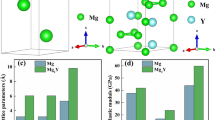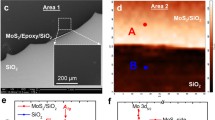Abstract
Adhesion property and bonding characteristic between ceramic TiN and two-dimensional MoS2 (2D-MoS2) were investigated to discuss the feasibility of preparation of MoS2 on TiN by first-principles simulation. The results show that for all interface models constructed, 2D-MoS2 can adhere to TiN by the analysis of work of adhesion (Wad), where the bonding strength of TiN(111) Ti-terminated/2D-MoS2(0001) interface (Ti/S interface) is larger than that of TiN(111) N-terminated/2D-MoS2(0001) interface (N/S interface). By the analysis of charge density and charge density difference of Ti/S interfaces, there is strong aggregation of electron between interfacial atoms, which indicates that chemical bonds are formed between the interfacial atoms at Ti/S interfaces. By partial density of states (PDOS) of interfacial atoms at Ti/S interfaces, the bonding mode of interfacial atoms is the mixture of metal bond and polar covalent bond. In addition, the bonding of interfacial atoms is mainly contributed by hybridization of Ti-3d and S-2p orbitals and the interface metallicity mainly comes from electrons of Ti-3p orbital.
Graphic abstract










Similar content being viewed by others
References
M. Bar-Hena, I. Etsionb, Experimental study of the effect of coating thickness and substrate roughness on tool wear during turning. Tribol. Int. 110, 341–347 (2017). https://doi.org/10.1016/j.triboint.2016.11.011
C.Y.H. Lim, S.C. Lim, K.S. Lee, The performance of TiN-coated high speed steel tool inserts in turning. Tribol. Int. 32, 393–398 (1999). https://doi.org/10.1016/S0301-679X(99)00066-3
A. Torgovkin, S. Chaudhuri, J. Malm, T. Sajavaara, I.J. Maasilta, Normal-metal–insulator–superconductor tunnel junction with atomic-layer-deposited titanium nitride as superconductor. IEEE Trans. Appl. Supercond. 25(3), 1–4 (2015). https://doi.org/10.1109/TASC.2014.2383914
C. Gong, H. Meng, X. Zhao, X. Zhang, L. Yu, J. Zhang, Z. Zhang, Unique static magnetic and dynamic electromagnetic behaviors in titanium nitride/carbon composites driven by defect engineering. Sci. Rep. 6, 18927 (2016). https://doi.org/10.1038/srep18927
C. Gong, C. Yan, J. Zhang, X. Cheng, H. Pan, C. Zhang, L. Yu, Z. Zhang, Room-temperature ferromagnetism evolution in nanostructured titanium nitride superconductors-the influence of structural defects. J. Mater. Chem. (2011). https://doi.org/10.1039/c1jm12359a
K.S. Novoselov, Electric field effect in atomically thin carbon films. Science 306(5696), 666–669 (2004). https://doi.org/10.1126/science.1102896
H. Bao, L. Wang, C. Li, J. Luo, Structural characterization and identification of graphdiyne and graphdiyne-based materials. ACS Appl. Mater. Int. 11(3), 2717–2729 (2019). https://doi.org/10.1021/acsami.8b05051
C.N. Rao, K. Gopalakrishnan, U. Maitra, Comparative study of potential applications of graphene, MoS2, and other two-dimensional materials in energy devices, sensors, and related areas. ACS Appl. Mater. Int. 7(15), 7809–7832 (2015). https://doi.org/10.1021/am509096x
Y. Guo, C. Dun, J. Xu, P. Li, W. Huang, J. Mu, C. Hou, C.A. Hewitt, Q. Zhang, Y. Li, D.L. Carroll, H. Wang, Wearable thermoelectric devices based on Au-decorated two-dimensional MoS2. ACS Appl. Mater. Interface 10(39), 33316–33321 (2018). https://doi.org/10.1021/acsami.8b10720
K. Tang, W. Qi, Y. Li, T. Wang, Electronic Properties of van der waals heterostructure of black phosphorus and MoS2. J Phys Chem C 122(12), 7027–7032 (2018). https://doi.org/10.1021/acs.jpcc.8b01476
U. Krishnan, M. Kaur, K. Singh, M. Kumar, A. Kumar, A synoptic review of MoS2: synthesis to applications. Superlattice Microstruct. 128, 274–297 (2019). https://doi.org/10.1016/j.spmi.2019.02.005
D. Berman, A. Erdemir, A.V. Sumant, Graphene: a new emerging lubricant. Mater Today 17(1), 31–42 (2013). https://doi.org/10.1016/j.mattod.2013.12.003
D. Berman, A. Erdemir, A.V. Sumant, Approaches for achieving superlubricity in two-dimensional materials. ACS Nano 12(3), 2122–2137 (2018). https://doi.org/10.1021/acsnano.7b09046
U. Dasgupta, S. Chatterjee, A.J. Pal, Thin-film formation of 2D MoS2 and its application as a hole-transport layer in planar perovskite solar cells. Sol. Energy Mater. Sol. C 172, 353–360 (2017). https://doi.org/10.1016/j.solmat.2017.08.012
P.K. Chow, E. Singh, B.C.V. Neto, Wetting of mono and few-layered WS2 and MoS2 films supported on Si/SiO2 substrates. ACS Nano (2015). https://doi.org/10.1021/nn5072073
A. Arulraj, M. Ramesh, B. Subramanian, G. Senguttuvan, In-situ temperature and thickness control grown 2D-MoS2 via pulsed laser ablation for photovoltaic devices. Sol. Energy 174, 286–295 (2018). https://doi.org/10.1016/j.solener.2018.08.056
Q. Fang, Y. Huang, Y. Miao, K. Xu, Y. Li, F. Ma, Interfacial defect engineering on electronic states of two-dimensional AlN/MoS2 heterostructure. J. Phys. Chem. C 121, 6605–6613 (2017). https://doi.org/10.1021/acs.jpcc.6b11270
S. Yu, S.J. Ran, H. Zhu, K. Eshun, C. Shi, K. Jiang, K.M. Gu, F.J. Seo, Q.L. Li, Study of interfacial strain at the α-Al2O3/monolayer MoS2 interface by first principle calculations. Appl. Surf. Sci. 428, 593–597 (2018). https://doi.org/10.1016/j.apsusc.2017.09.203
M. Sharma, P. Jamdagni, A. Kumar, P.K. Ahluwalia, Electronic, dielectric and mechanical properties of MoS2/SiC hybrid bilayer: a first principle study. Phys. E. 71, 49–55 (2015). https://doi.org/10.1016/j.physe.2015.02.024
J.J. Chen, Z.S. Lin, S.J. Bull, C.L. Phillips, P.D. Bristowe, Experimental and modelling techniquesfor assessing the adhesion of very thincoatings on glass. J Phys D 42, 214003 (2009). https://doi.org/10.1088/0022-3727/42/21/214003
C. Stampfl, W. Mannstadt, R. Asahi, A.J. Freeman, Electronic structure and physical properties of early transition metal mononitrides: density-functional theory LDA, GGA, and screened-exchange LDA FLAPW calculations. Phys. Rev. B (2001). https://doi.org/10.1103/PhysRevB.63.155106
X. Fan, B. Chen, M. Zhang, D. Li, Z. Liu, C. Xiao, First-principles calculations on bonding characteristic and electronic property of TiC (111)/TiN (111) interface. Mater Des. 112, 282–289 (2016). https://doi.org/10.1016/j.matdes.2016.09.053
S. Kumar, J. Kumar, O.S.K.S. Sastri, Effect of mechanical strain on electronic properties of bulk MoS2, in International Conference of Condensed Matter Physics. AIP Publishing LLC (2015). https://doi.org/10.1063/1.4915402.
R.G. Dickinson, L. Pauling, The crystal structure of molybdenite. Acta Crystallogr. 26(10), 1534–1540 (2001). https://doi.org/10.1107/S0567740870004442
L. Rao, H. Liu, S. Liu, Z. Shi, X. Ren, Y. Zhou, Q. Yang, Interface relationship between TiN and Ti substrate by first-principles calculation. Comput. Mater. Sci. 155, 36–47 (2018). https://doi.org/10.1016/j.commatsci.2018.08.028
J.E. Greene, J.E. Sundgren, L. Hultman, First-principles study of polar Al/TiN(111) interfaces. Acta Mater. 52, 3681–3688 (2004). https://doi.org/10.1016/j.actamat.2004.04.022
J.E. Greene, J.E. Sundgren, L. Hultman, Development of preferred orientation in polycrystalline TiN layers grown by ultrahigh vacuum reactive magnetron sputtering. Appl. Phys. Lett. 67(20), 2928–2930 (1995). https://doi.org/10.1063/1.114845
M.I. Jones, I.R. McColl, D.M. Grant, Effect of substrate preparation and deposition conditions on the preferred orientation of TiN coatings deposited by RF reactive sputtering. Surf. Coat. Tech. 132(2–3), 143–151 (2000). https://doi.org/10.1016/S0257-8972(00)00867-7
M. Lattemann, U. Helmersson, J.E. Greene, Fully dense, non-faceted 111-textured high power impulse magnetron sputtering TiN films grown in the absence of substrate heating and bias. Thin Solid Films 518(21), 5978–5980 (2010). https://doi.org/10.1016/j.tsf.2010.05.064
B.L. Bramfitt, The effect of carbide and nitride additions on the heterogeneous nucleation behavior of liquid iron. Metall. Mater. Trans. B 1(7), 1987–1995 (1970). https://doi.org/10.1007/BF02642799
X.W. Fan, B. Chen, M.M. Zhang, First-principles calculations on bonding characteristic and electronic property of TiC (111)/TiN (111) interface. Mater. Des. 112, 282–289 (2016). https://doi.org/10.1016/j.matdes.2016.09.053
S. Wang, H. Ye, Theoretical studies of solid–solid interfaces. Curr. Opin. Solid St M 10(1), 26–32 (2006). https://doi.org/10.1016/j.cossms.2006.06.001
W.Y. Choe, G.J. Miller, E.M. Levin, Crystal structure and magnetism of Gd2MgGe2. J. Alloys Compd. 329, 121–130 (2001). https://doi.org/10.1016/S0925-8388(01)01568-7
Y.F. Li, Y.M. Gao, B. Xiao, Theoretical calculations on the adhesion, stability, electronic structure, and bonding of Fe/WC interface. Appl. Surf. Sci. 257, 5671–5678 (2011). https://doi.org/10.1016/j.apsusc.2011.01.072
J. Yang, J.H. Huang, D.Y. Fan, First-principles investigation on the electronic property and bonding configuration of NbC (111)/NbN (111) interface. J. Alloys Compd. 689, 874–884 (2016). https://doi.org/10.1016/j.jallcom.2016.08.040
B.Y. Tong, L.J. Sham, Application of a self-consistent scheme including exchange and correlation effects to atoms. Phys. Rev. 144(1), 1–4 (1966). https://doi.org/10.1103/PhysRev.144.1
G. Kresse, Efficient iterative schemes for ab initio total-energy calculations using a plane-wave basis set. Phys. Rev. B 54(16), 11169–11186 (1996). https://doi.org/10.1103/physrevb.54.11169
G. Kresse, J. Hafner, Ab initio molecular-dynamics simulation of the liquid-metal-amorphous-semiconductor transition in germanium. Phys. Rev. B 49(20), 14251 (1994). https://doi.org/10.1103/PhysRevB.49.14251
J.P. Perdew, K. Burke, M. Ernzerhof, Generalized gradient approximation made simple. Phys. Rev. Lett. (1996). https://doi.org/10.1103/PhysRevLett.77.3865
P.E. Blochl, Projector augmented-wave method. Phys. Rev. B 50, 17953–17979 (1994). https://doi.org/10.1103/PhysRevB.50.17953
J.D. Pack, H.J. Monkhorst, Special points for brillouin-zone integrations—a reply. Phys. Rev. B 16(4), 1748–1749 (1997). https://doi.org/10.1103/PhysRevB.16.1746
Acknowledgments
The authors would like to express their gratitude for projects supported by the National Natural Science Foundation of China (No.51771167 and No.51705447).
Author information
Authors and Affiliations
Corresponding authors
Ethics declarations
Conflict of interest
The authors declare that they have no known competing financial interests or personal relationships that could have appeared to influence the work reported in this paper.
Supplementary Information
Below is the link to the electronic supplementary material.
Rights and permissions
About this article
Cite this article
Rao, L., Liu, H., Shao, W. et al. Adhesion property and bonding characteristic between TiN and 2D-MoS2: A first-principles study. Journal of Materials Research 36, 1990–2000 (2021). https://doi.org/10.1557/s43578-021-00197-3
Received:
Accepted:
Published:
Issue Date:
DOI: https://doi.org/10.1557/s43578-021-00197-3




